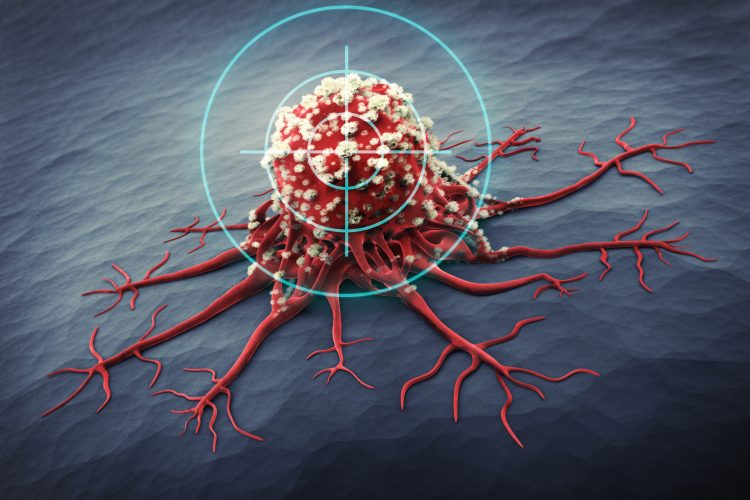Novel compound for targeted alpha therapy
Posted: 4 September 2024 | Drug Target Review | No comments yet
NpG-D-PSMA has shown great potential for targeted alpha therapy to combat prostate cancer.


Researchers at Chiba University have developed a new compound for targeted alpha therapy for prostate cancer, using a different alpha particle emitting radionuclide: astatine-211 (211At).
Globally, prostate cancer is the second most common cancer among men, with almost 300,000 new cases diagnosed each year. Reducing testosterone and other male hormones can be an effective treatment for this disease, but this method is ineffective once the disease progresses to metastatic castration-resistant prostate cancer (mCRPC), as the cancer becomes resistant to both conventional hormonal therapies and chemotherapy.
mCRPC tumour cells typically overexpress prostate-specific membrane antigen (PSMA). In targeted alpha therapy, a radioactive atom such as actinium-225 (225Ac) is attached to a compound that binds strongly to PSMA. During the decay of the radioactive atom, alpha particles that are harmful to nearby cells are emitted. However, the production of 225Ac is very low, necessitating alternative therapeutic strategies.
Biomarkers are redefining how precision therapies are discovered, validated and delivered.
This exclusive expert-led report reveals how leading teams are using biomarker science to drive faster insights, cleaner data and more targeted treatments – from discovery to diagnostics.
Inside the report:
- How leading organisations are reshaping strategy with biomarker-led approaches
- Better tools for real-time decision-making – turning complex data into faster insights
- Global standardisation and assay sensitivity – what it takes to scale across networks
Discover how biomarker science is addressing the biggest hurdles in drug discovery, translational research and precision medicine – access your free copy today
Led by Tomoya Uehara, the team generated a novel compound using a different alpha particle emitting radionuclide: astatine 211 (211A), which addressed deastatination, a key challenge associated with 211At-based compounds for targeted alpha therapy. Deastatination prevents the drug from combatting the cancer, and also releases a radioactive payload to other tissues in the body, resulting in organ damage. The team, to circumvent this issue, used a chemical structure they had studied previously.
Uehara commented: “Recently, we developed a neopentyl derivative with two hydroxy groups, which we referred to as an ‘NpG structure,’ as a 211At-labelling moiety that could stably retain 211At in vivo.” He added: “Based on these past results, we hypothesised that the NpG structure could be used to design a variety of 211At-labelled PSMA-targeting derivatives.”
They designed and synthesised a pair of such derivatives, each containing a different glutamic acid linker between the NpG structure and the PSMA-targeting region, specifically asymmetric urea. The compounds were called NpG-L-PSMA and NpG-D-PSMA.
Tests were conducted using iodine-125 (125I) bound to these compounds instead of 211At, as 125I is more abundant and easier to obtain. In experiments in mice bearing tumours from a human prostate cancer cell line, they discovered that both [125I]I-NpG-D-PSMA and [125I]I-NpG-L-PSMA showed low accumulation in the stomach and thyroid. This suggested that they had high in vivo stability against deiodination. However, [125I]I-NpG-D-PSMA showed higher accumulation in tumour tissue than [125I]I-NpG-L-PSMA.
When the team did a series of experiments using [211At]At-NpG-D-PSMA, the compound exhibited high accumulation in tumours and low accumulation in vital organs, like its iodine containing counterpart.
Therefore, these results demonstrate the potential of NpG-D-PSMA for targeted alpha therapy. Uehara concluded: “Our study showed that the neopentyl glycol structure, which can stably hold radiohalogens like 211At and 125I in vivo, may be applicable as a tumour-targeting agent. The use of the neopentyl glycol structure as a radiohalogen labelling moiety could enable the production of nuclear medicines for various types of tumours, thereby contributing greatly to human welfare.”
This study was published in EJNMMI Radiopharmacy and Chemistry.
Related topics
Cancer research, Drug Development, Oncology, Therapeutics
Related conditions
Cancer Research, metastatic castration-resistant prostate cancer (mCRPC), Prostate cancer
Related organisations
Chiba University
Related people
Tomoya Uehara (Chiba University)








